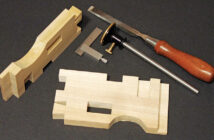Ornamental Turning Made Easy – more:
Chris Hart focuses on setting up the system and prepares a couple of box lids prior to decoration.
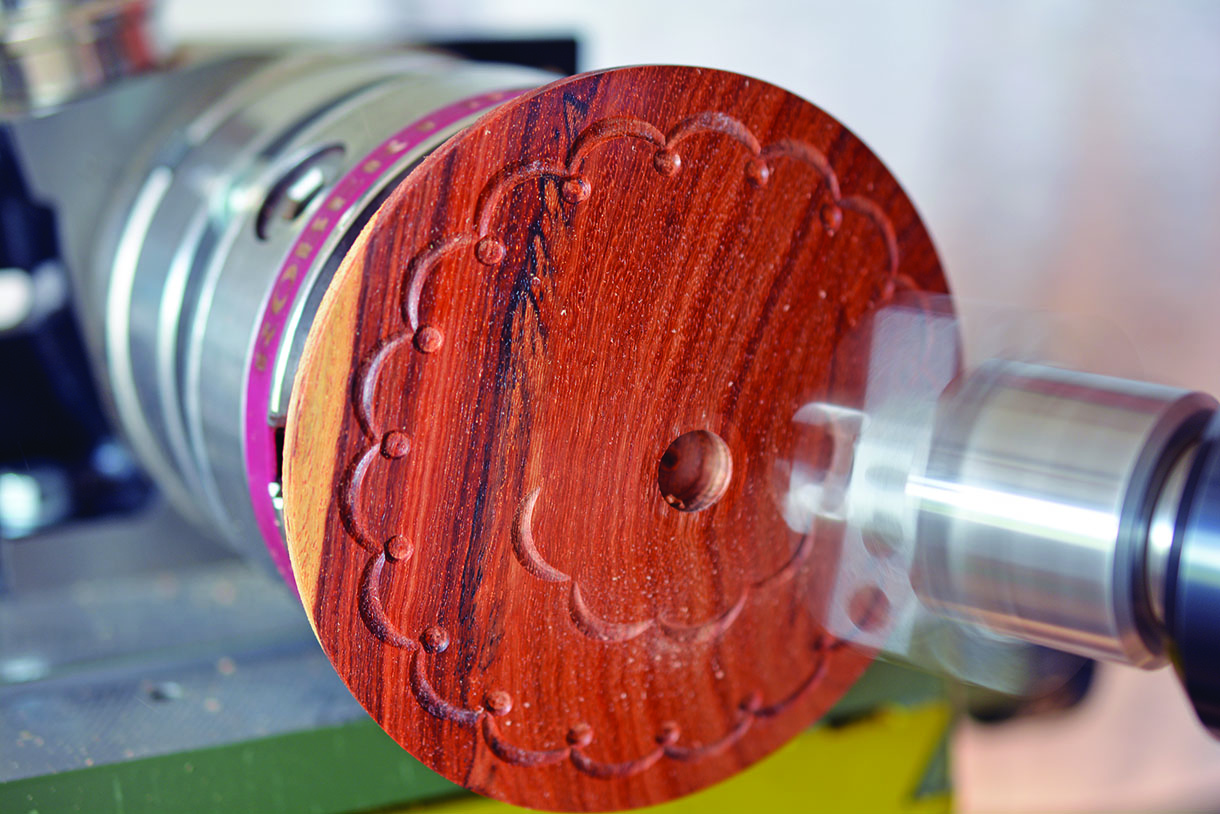
Cutting the inner ring on the lid multi patterned lid of a finial box
The turning required for this month’s project is pretty straightforward. However, the decoration of the box lids will require a little thought and concentration. Throughout this article I hope to provide 1% of the inspiration, therefore making it the readers role to supply 99% of perspiration in the form of concentration – more on this later – highlighting the results when concentration lapses.
Preparing the work
The first project is a box lid in curupay (Anadenthera culbrina), having finished the base and inside the lid, reverse the lid into a jam chuck. The shape of the lid in this case is a sloping hut roof style, it is, at this point, that care must be taken. The objective is to achieve a slope, which is flat without hills or valleys, neither convex or concave. Cut this with a spindle gouge ensuring the top is perfectly flat with a straight edge or ruler. A sheet of white paper underneath will help determine this. If you are unable to achieve the flatness
or finish required, try by sheer cutting using a gouge or scraper, alternately scraping with a negative rake scraper is also a good option.
Sanding is best achieved with the abrasive wrapped around a cork block, which will preserve the integrity of the flatness. After sanding, apply a coat of sanding sealer or preferred finish. The need for absolute flatness is because, provided the work is presented to the cutter at right angles, a cut of equal thickness and depth will be achieved.
This simple style of box lends itself to decoration and there are many patterns which can be applied to this shape of lid. When it is finished the lid must remain on the chuck, however, the chuck may be removed from the lathe.
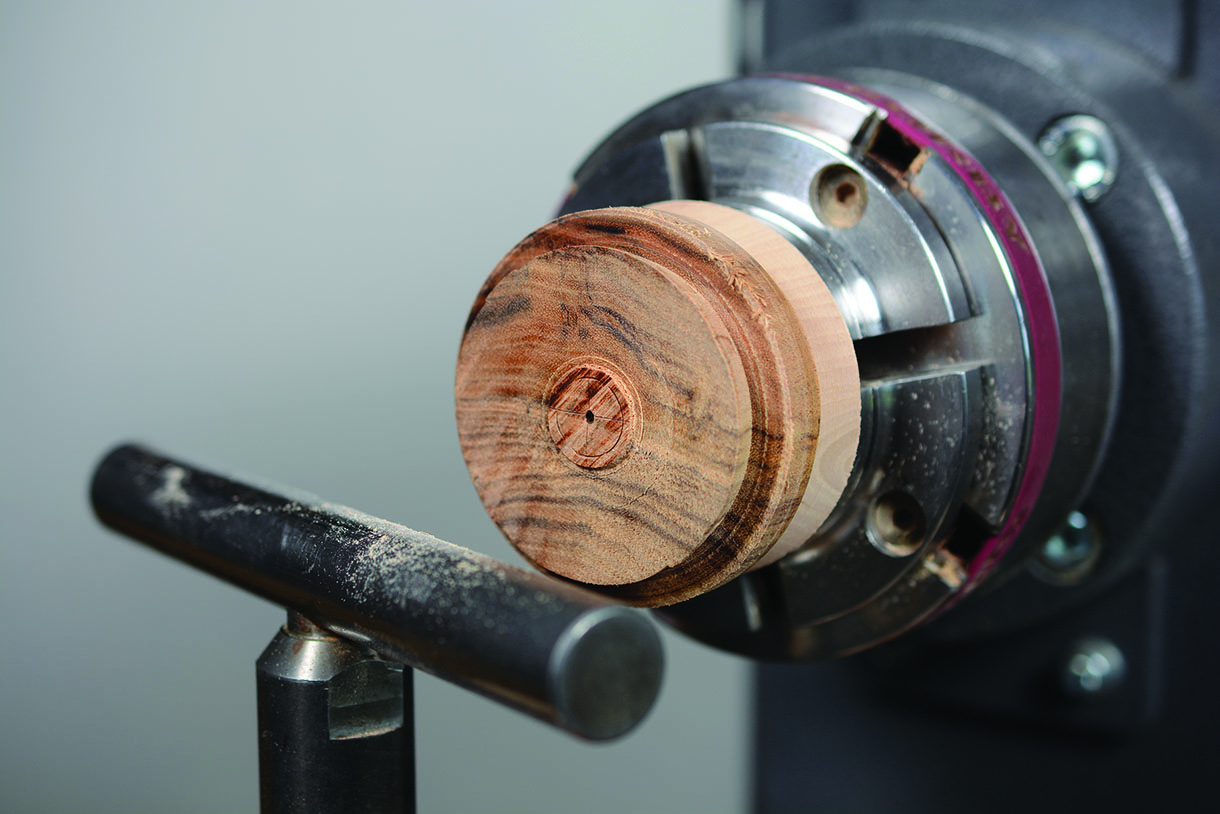
Lid reversed into a jam chuck
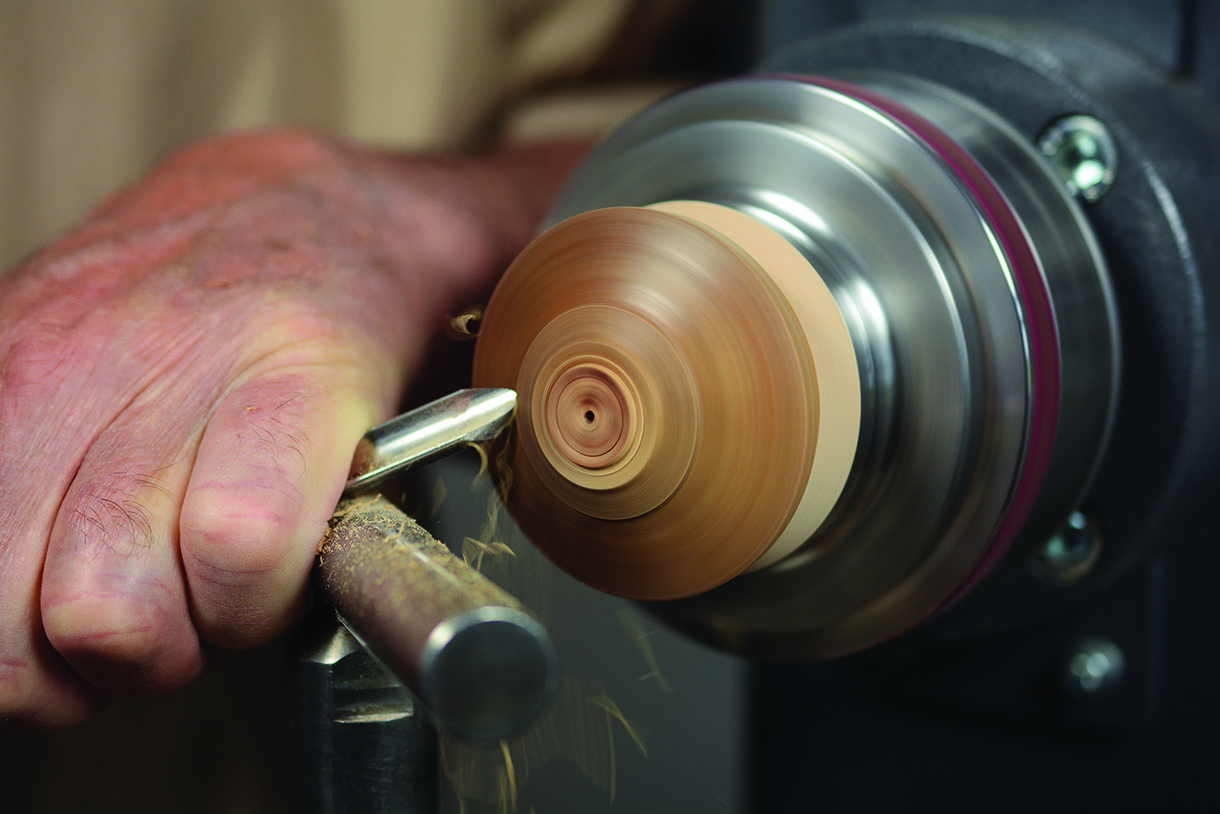
Cutting the lid with a spindle gouge
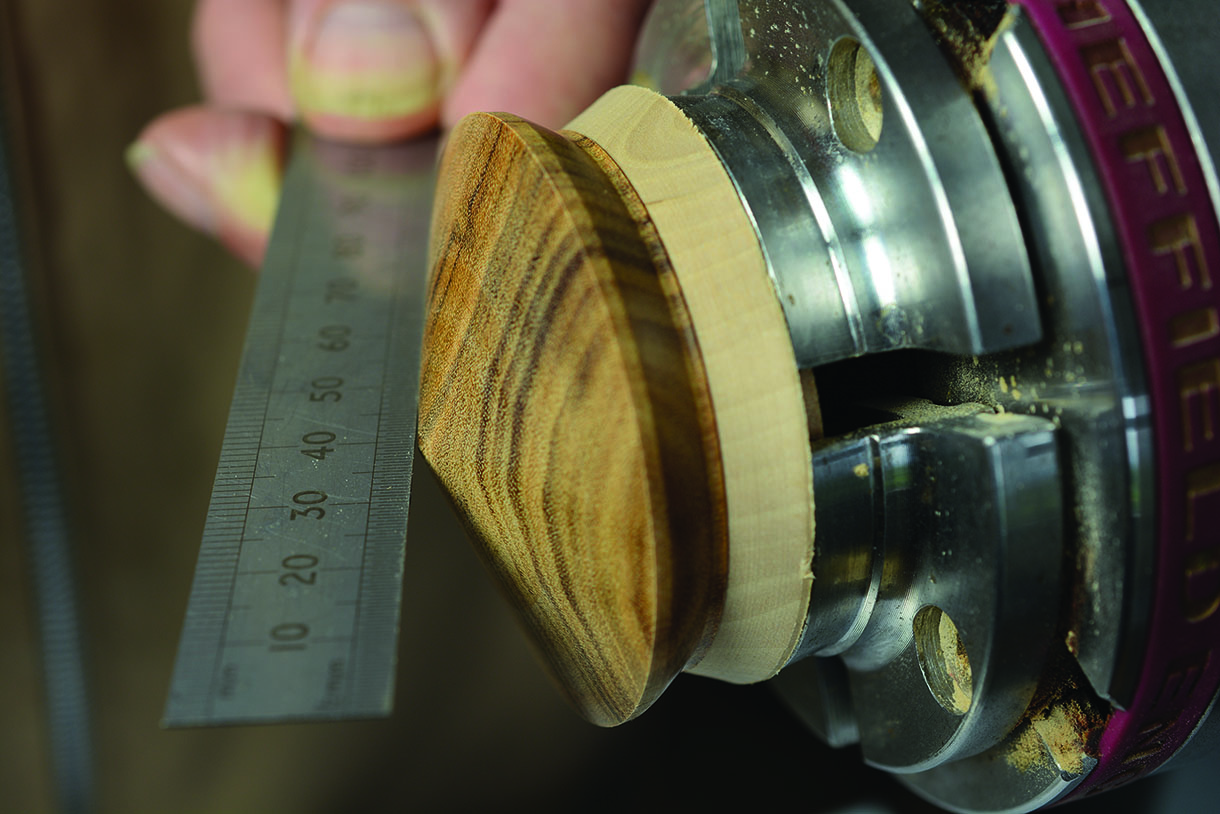
Checking the lid for flatness
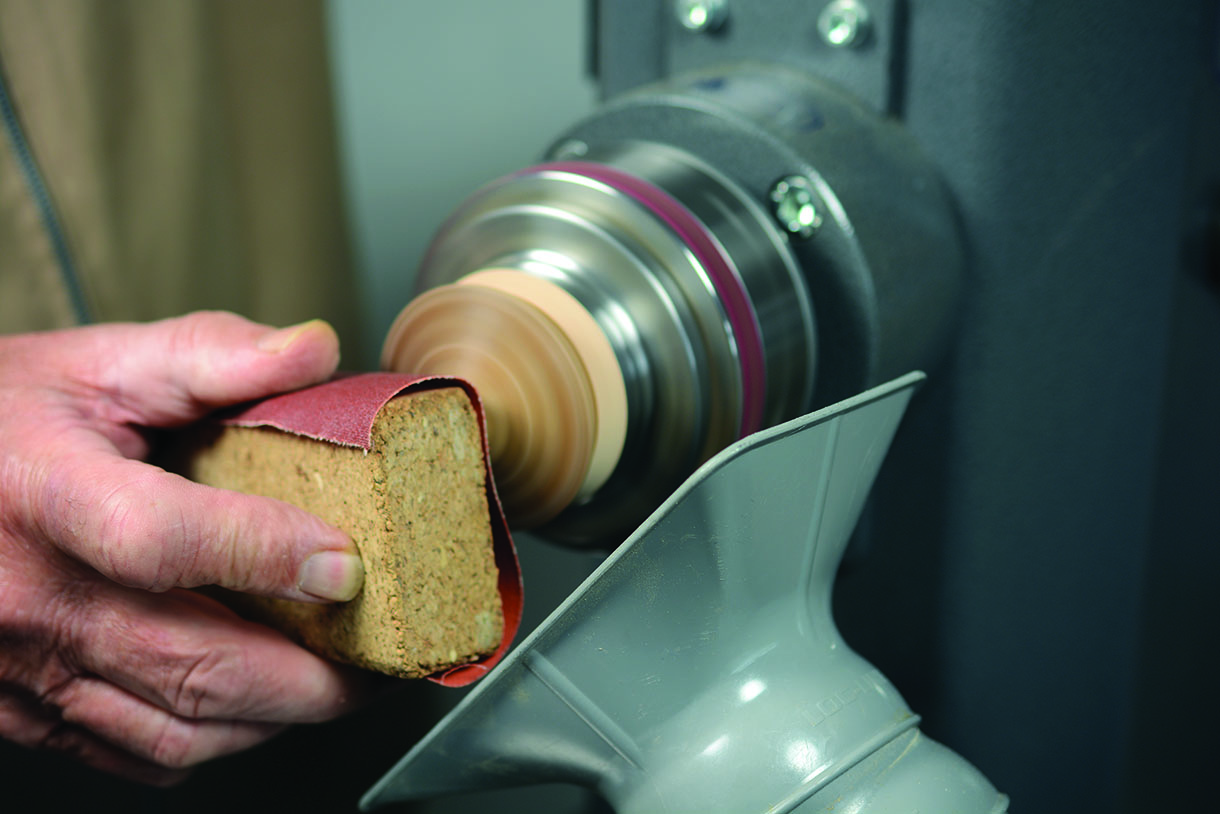
Sanding the lid with a block
Setting up the system
Having finished the preparation of the lid, the tailstock and banjo are removed replacing them with the baseboard complete with the compound table. Securing onto the bed bars of the lathe, mount the rotary table ensuring it sits square on the compound table by using an engineer’s set square. The rotation is activated by the handle on the top with a locking screw, two scales are provided, one on the circumference graduated in 1° increments, the other on the handle, which is a Vernier scale in tenths. It is this scale that is used to make final adjustments. The fore and aft (X and Y) movement of the compound table is controlled by two handles, one full turn is 2mm, the graduations, which are 0.05mm. Locking screws for the slides are also provided.
At this stage the chuck needs to be mounted on to the rotary table with the lid still attached. The Barleycorn pattern, which is to be applied, requires a flat surface because the cut is a full circle without interruption, so therefore the surface needs to be aligned at 90° to the cutter. This is achieved by slacking the bolt on the mounting board and swinging the whole unit. To make sure I get perfect alignment I use a straight edge mounted on to a chuck to align the work, while a sheet of white paper underneath helps.
I have found this method to be the most accurate and versatile. While a long straight edge can be a little ungainly for small items requiring the spindle lock or indexing system to balance and lock in place, it comes into its own when aligning a large bowl or platter. Alternate methods are to use the surface of a faceplate or fix a wooden straight edge to the faceplate.
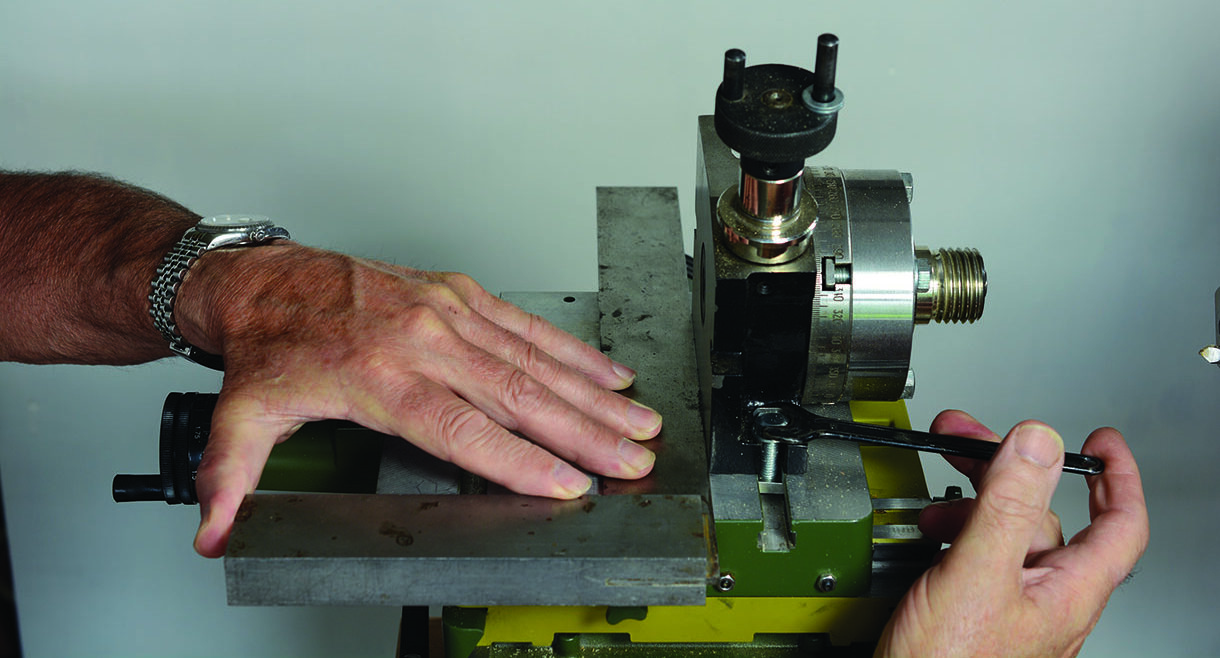
Setting the rotary table
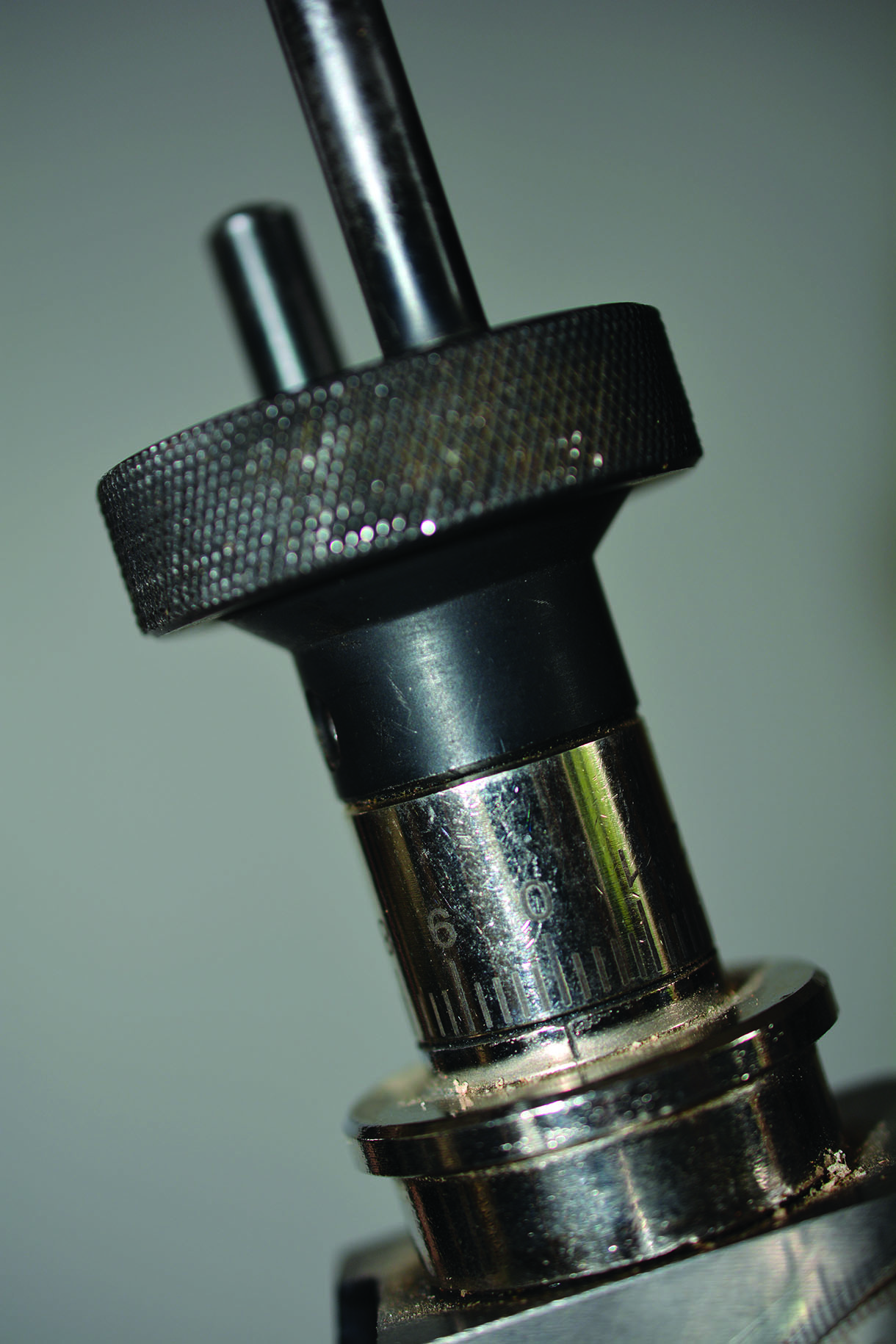
Vernier scale on rotary table
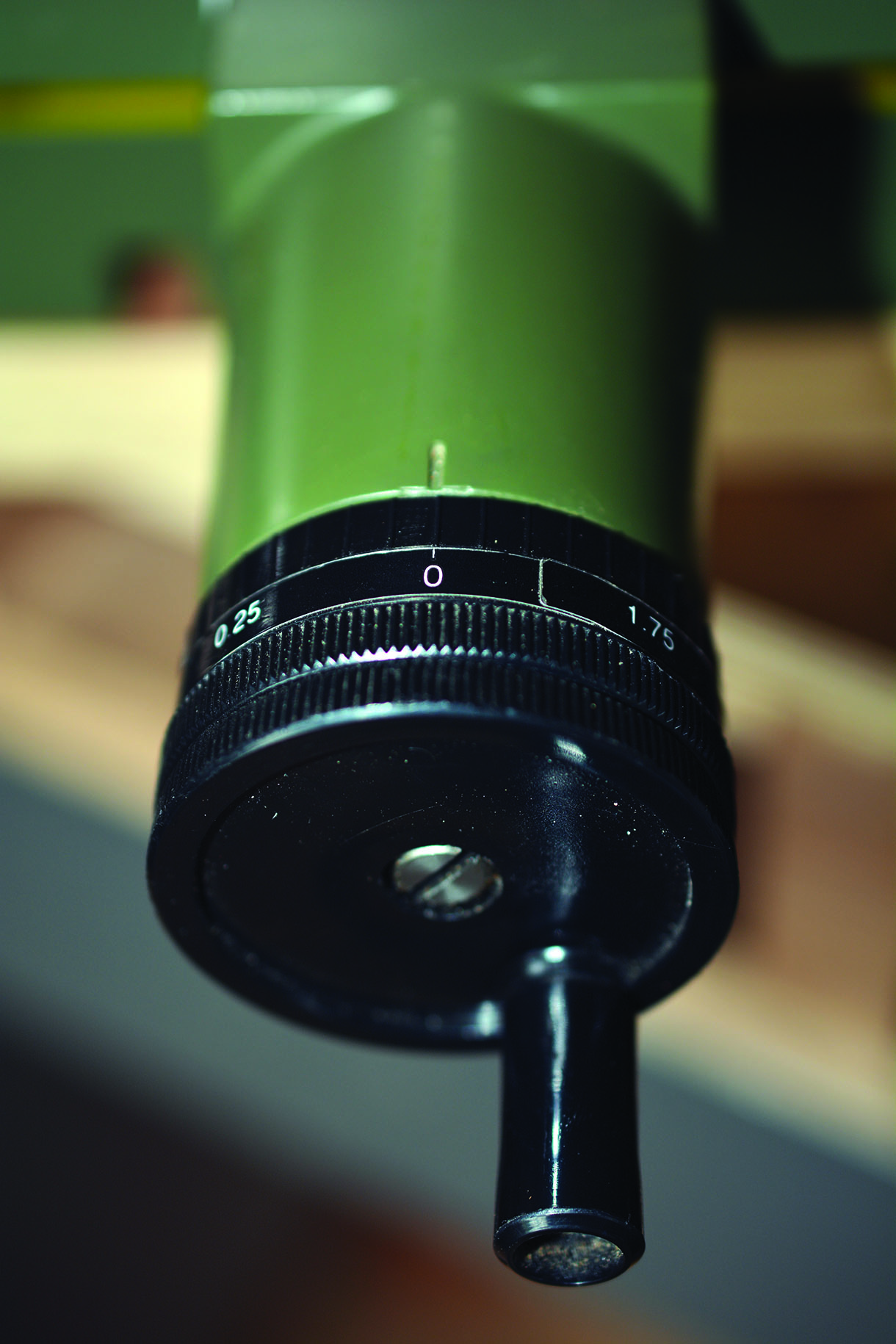
X and Y feed, and adjusting knobs
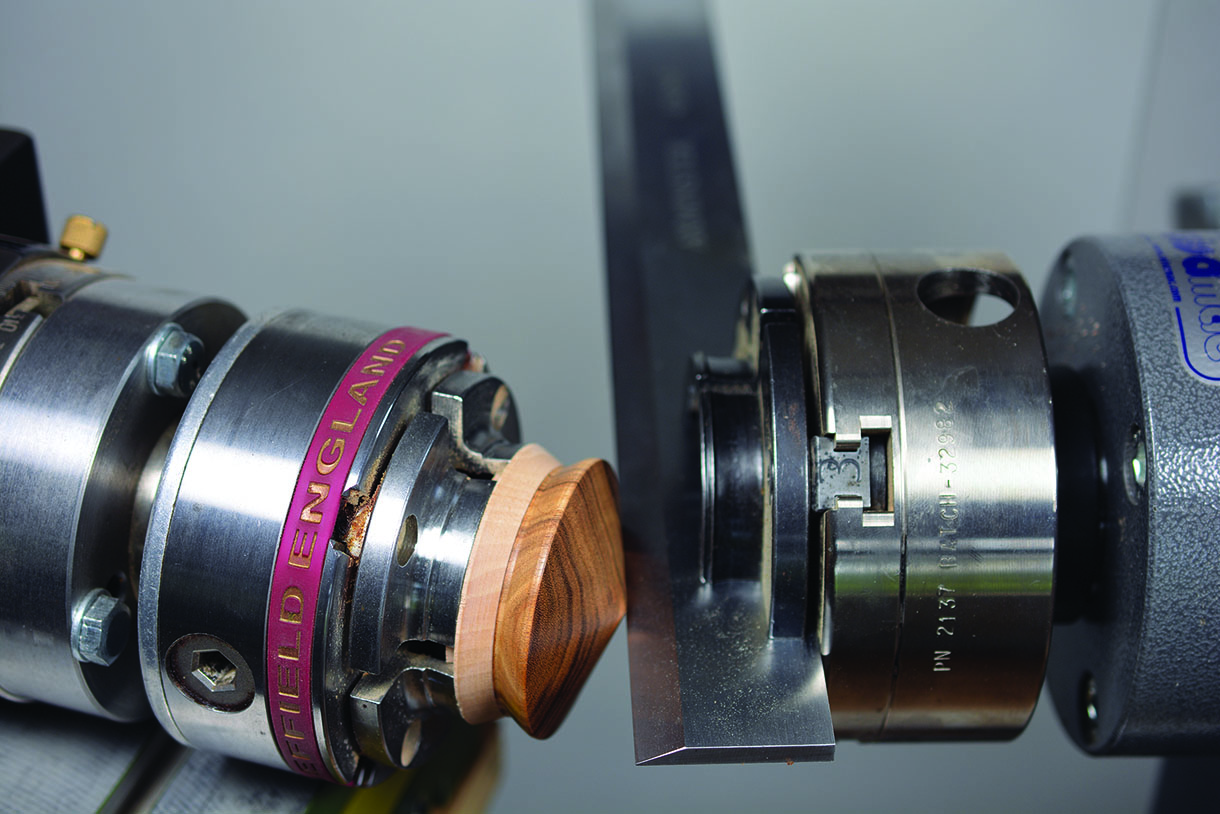
Setting the presentation angle
Setting up the boring head
Setting up the boring head is the next task. Start by inserting the boring head via the Morse taper into the spindle and secure with the drawbar. Insert the cutter into the middle slot on the head and secure with the retaining screw. The cutting edge must point upwards if the direction of travel is anticlockwise, the normal lathe direction. If the direction is reversed, turn the tool bit 180°. The swing of the head is adjusted by an Allen key inserted into the Vernier scale on the head and locking off with the screw on top.
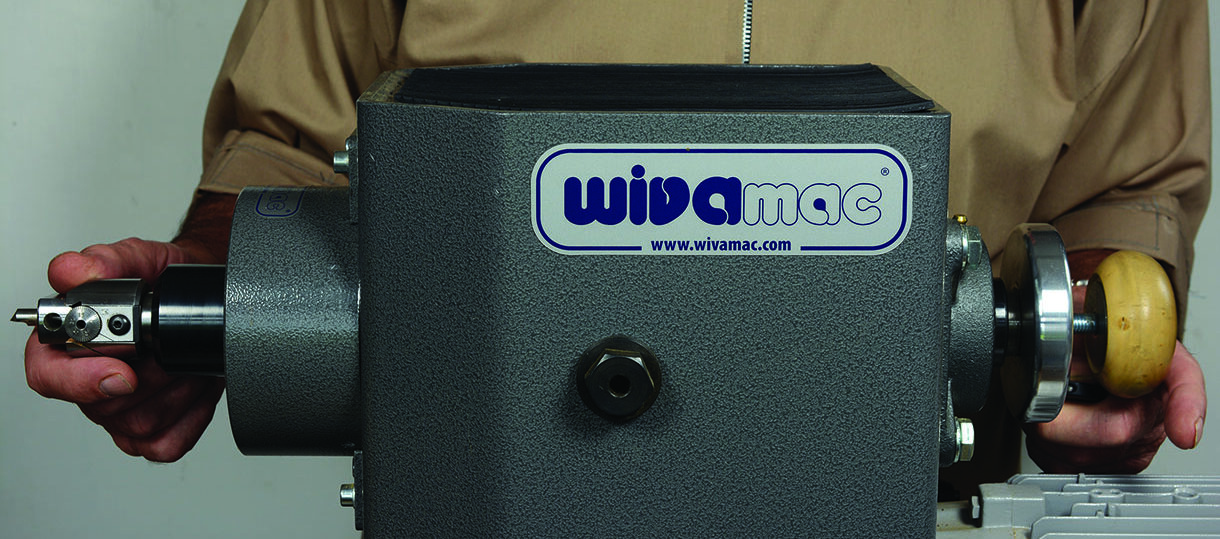
Inserting and securing the boring head
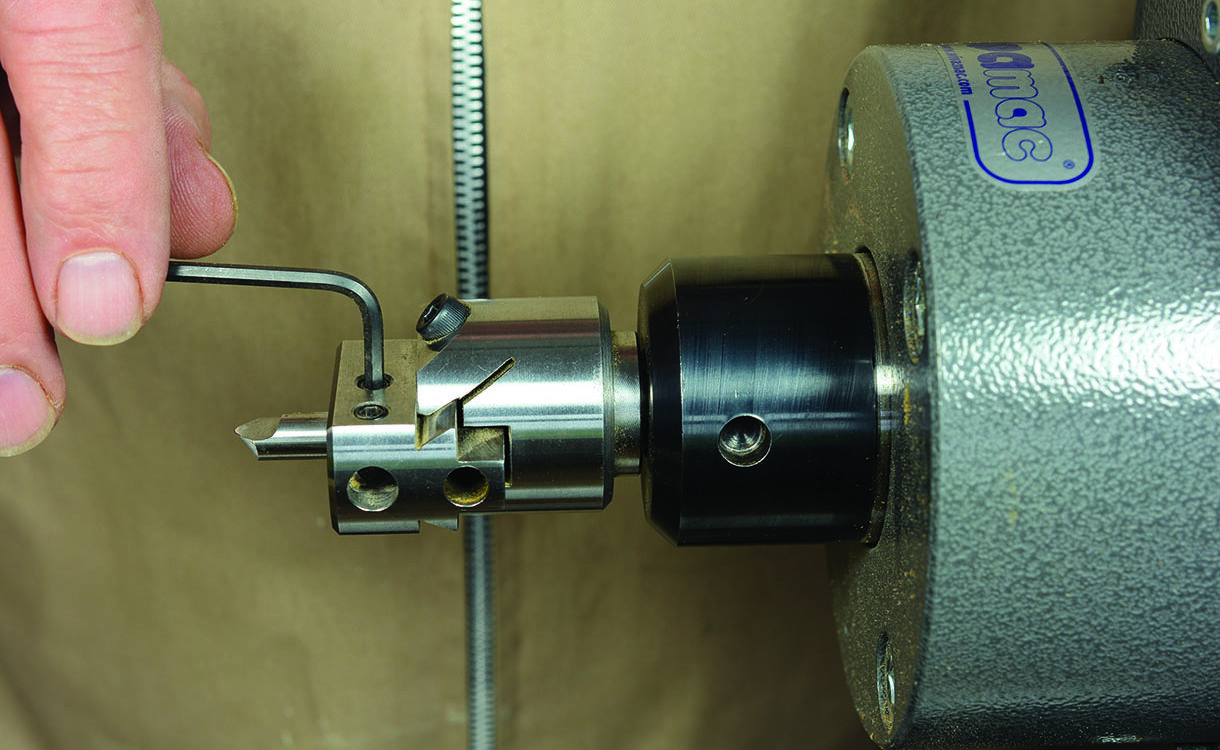
Securing the cutter
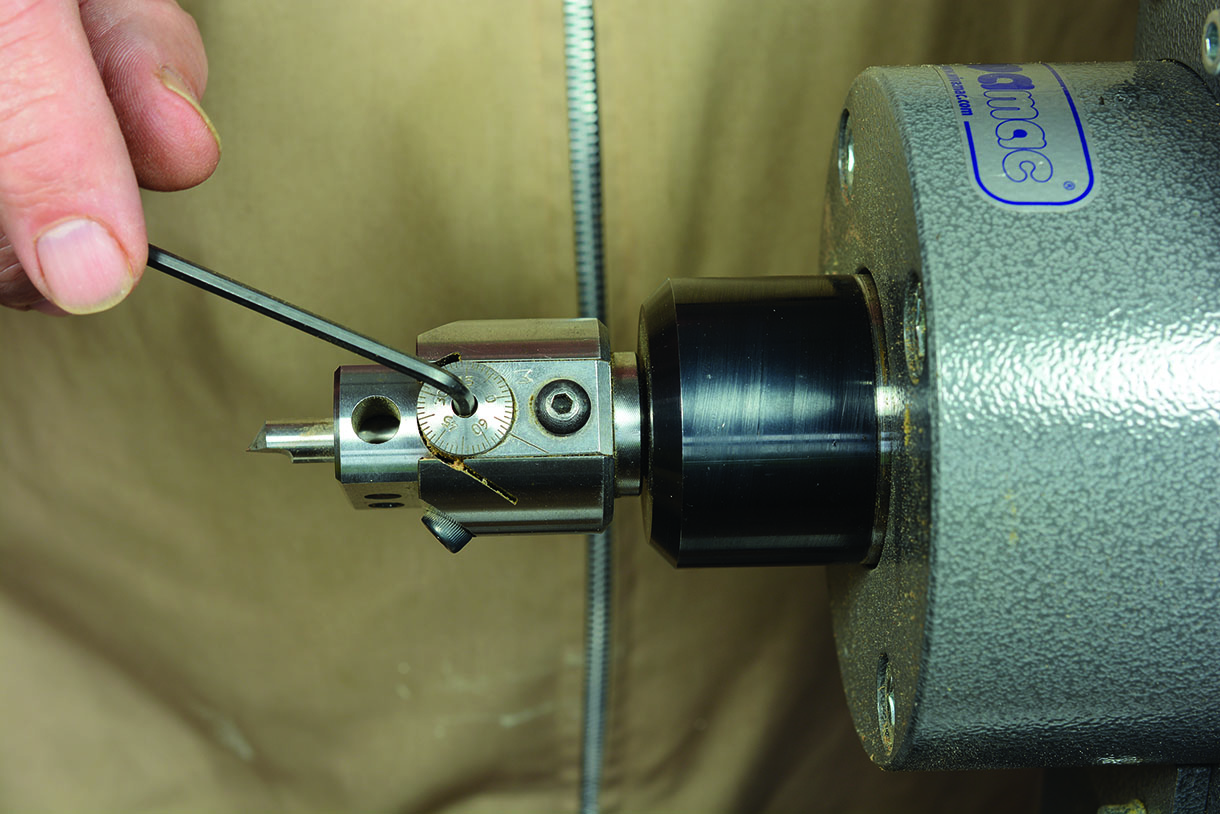
Swing adjusting screw
Determining and cutting the pattern
With the workpiece in the chuck and correctly aligned, together with the boring bar securely installed, complete with cutter. Determining the size of the decoration together with the pattern is the next step. The pattern is Barleycorn, although you will have seen various examples in previous parts. I make no apology for this, Barleycorn is the basis of most other patterns, depending on the size and spacing of the cuts. It takes on various guise’s which, when it is placed side-by-side, can look similar, but unrelated.
It is important that this pattern is mastered before moving on to others. Most skills and experience are built up by repetition and so it is with ornamental turning. By varying the increments, depth of cut and shape of work through experimenting, not only will you be surprised by the patterns produced, it will all add to a skill set and build confidence and experience, including a better understanding of how all the elements combine to make pleasing results, together with ideas about what works and what does not.
First, start by sliding and securing the compound unit to the cutter, making the fine adjustments with the X or Y knobs to advance the lid to almost, but not quite touching the cutter. We now need to determine the diameter of the cut together with the position of the circle. The diameter is achieved by adjusting the dovetail slide with the adjusting screw located in the Vernier scale. The diameter must be considered in relation to the position it occupies, achieving a pleasing balance. In this case I have positioned the cut (20mm diameter) just short of midway between the bottom edge and the top, leaving, about 5mm at the bottom edge and about 7.5mm per side at the top, which will make a nice crown 15mm overall. The overall diameter is 60mm, because of the angle, each side measures 35mm. The measurements are only to give the reader some idea of scale. There is absolutely no need to measure this, it is, in my opinion, best achieved by eye, rotating the cutter observing the positions on the lid.
Having decided the pattern, size and position, all that remains is to select the number of circles. The more circles the finer the pattern, however, some detail will be lost because of overlapping cuts. Less circles equals a coarse pattern which can look unbalanced on a small box lid. On this occasion I have chosen 18, because when a full 360° circle is divided by 18 it equates to a spacing of 20°. This will give a nicely balanced pattern with lots of fine detail in the extremities.
We are now ready to begin cutting however, in the interests of your health and safety, please carry out the safety checks prior to starting the lathe.
Once the safety checks are completed, check that the rotary table is in the zero position both on the main and Vernier scales, secure the locking screw. The compound table lateral or Y adjustment is not needed
on this occasion so lock off with retaining screw, however, it is prudent to mark its position (in case it is accidentally moved), the scale on the knob is spring loaded. Push the scale in and turn until zero is aligned with the mark.
Advance the cutter towards the workpiece, commencing cutting until the required depth of cut is reached. Setting the X scale back to zero when completed. Reverse the cut until well clear of the workpiece, advancing the rotary table by 20° via the handle on top. Using the Vernier scale as reference, (the most accurate), ensure the locking screw is tightened after each advance. Recommence cutting until the zero mark is reached, repeating the whole process until complete. More 99% perspiration!
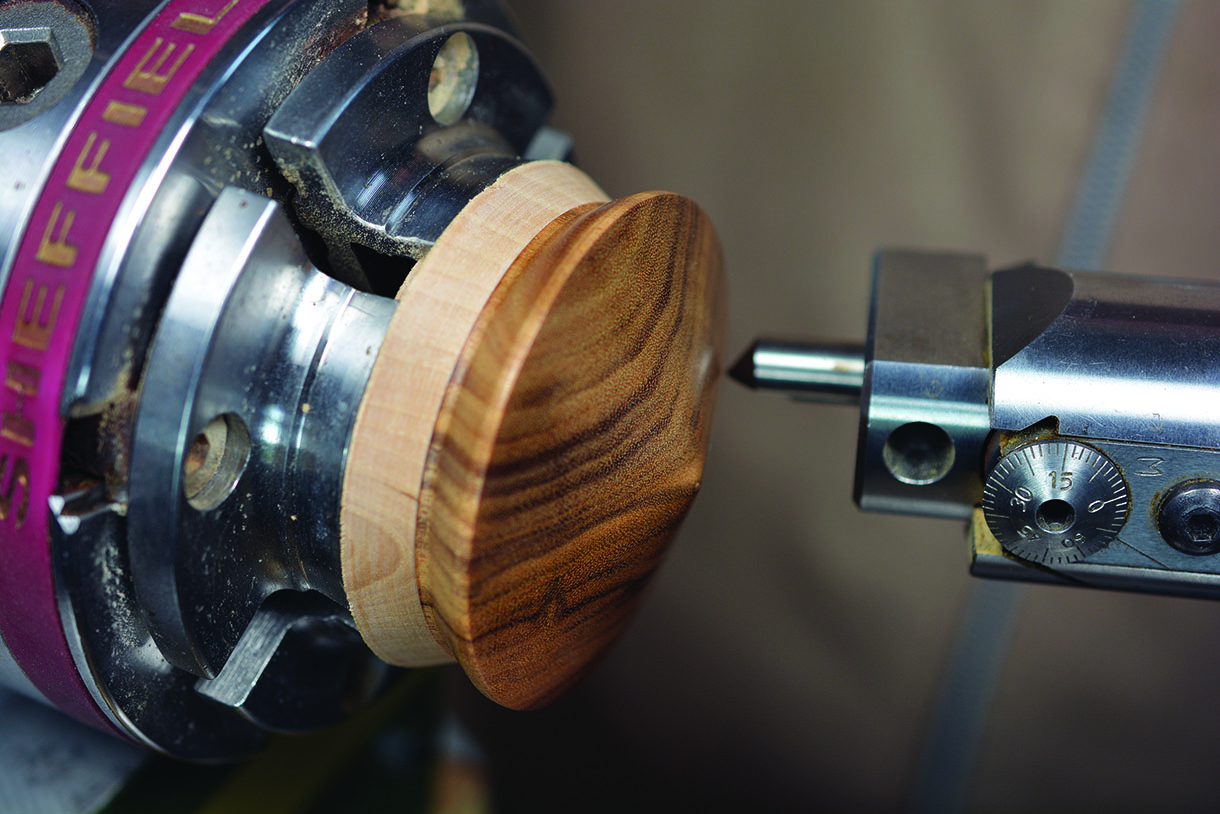
Setting the swing diameter outside
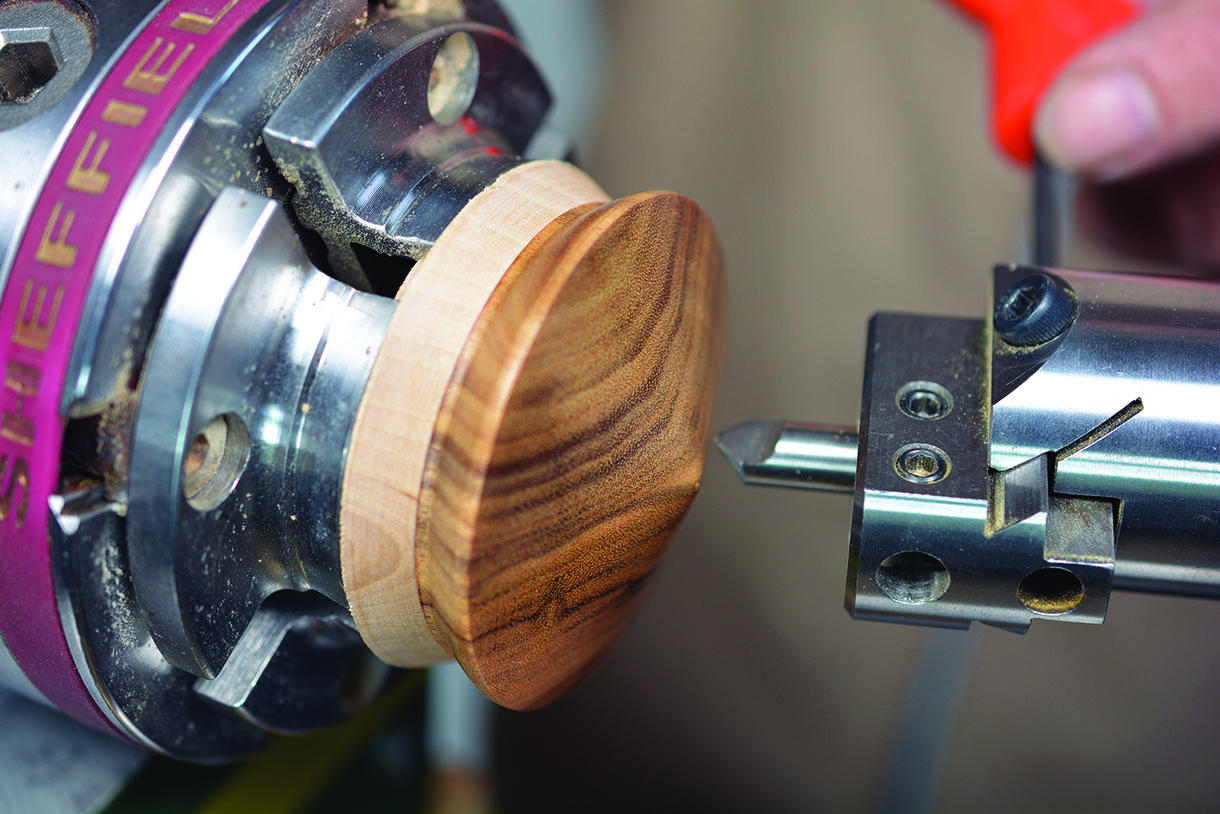
Setting the swing diameter inside
Safety check
• Boring bar is secured with drawbar.
• Tool and sliding dovetail screws are secure.
• Lathe spindle revolves freely without fouling.
• The unit is secured to bed bars.
• Workpiece is secure in chuck.
• Rotary table is secured to compound table.
• Cutter guard is in place.
• Lathe set to lowest speed.
• Rotary table locking screw is secure.
• Dust extraction is in place.
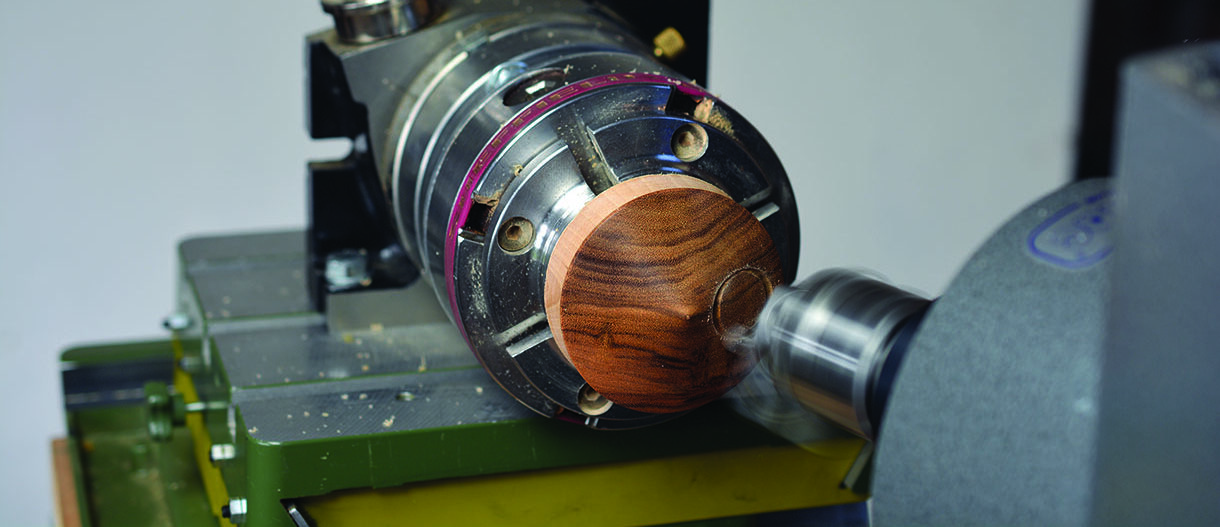
Making the first cut
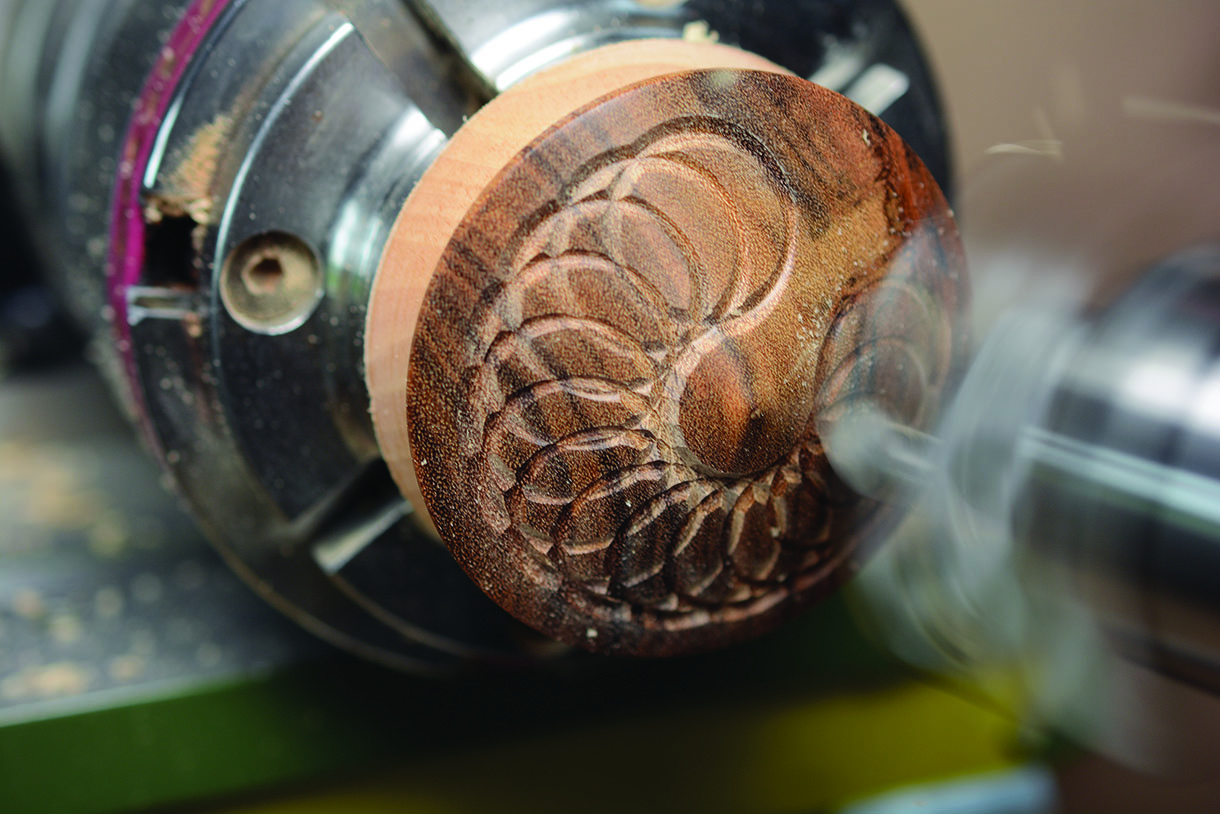
Progressing the cut
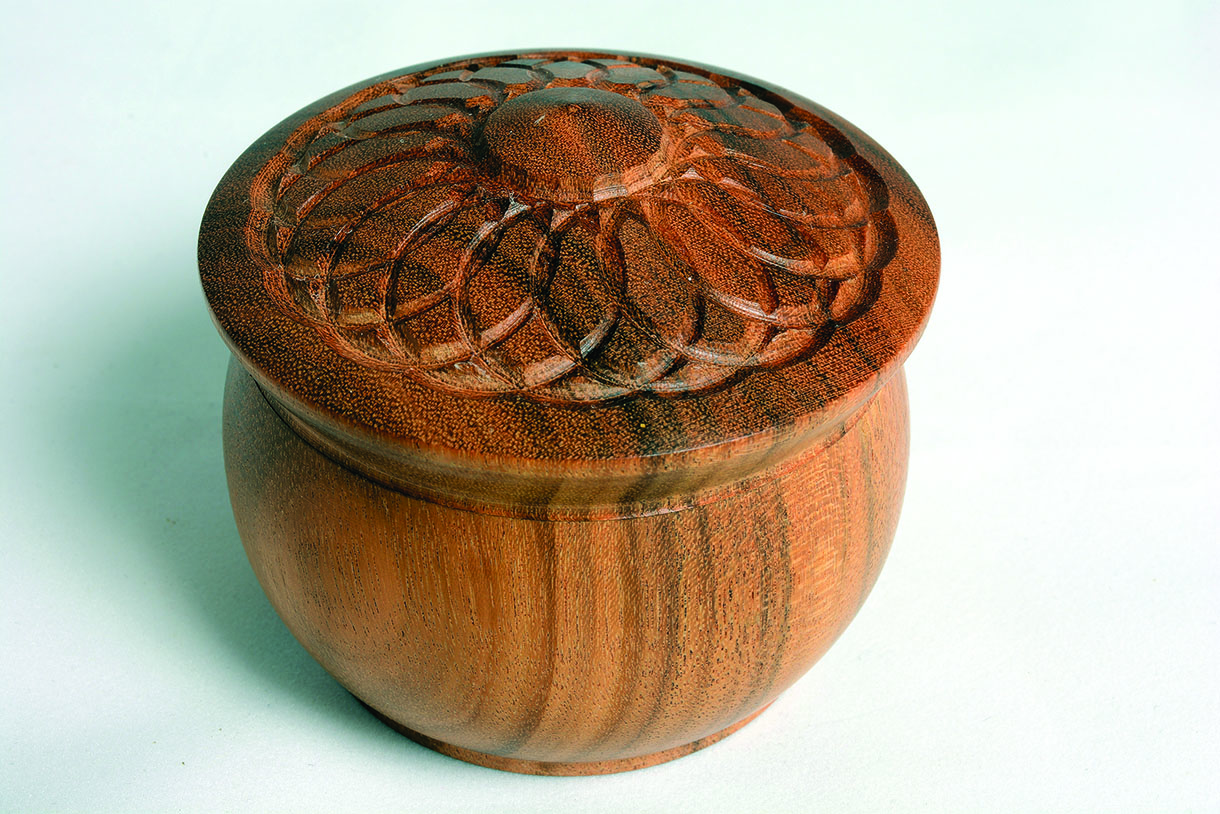
The finished box
Decorating a finial box
The second project is a trinket box lid inspired by my favourite and constant inspiration woodturning book Turned Boxes 50 Designs by Chris Stott. The woods used are beech (Fagus sylvatica) for the base, for the lid, West African pao rosa (Swartzia fistoloides) topped with an ebony (Dispyrus crassiflora) finial.
I turned, sanded and finished the lid exactly the same as the first project, plus drilling a 12mm hole to house the finial, which also doubles as a ‘jam chuck’ enabling the underside to be completed.
The pattern is two rows of crescent shaped semi-circles with a dot detail at the point of each intersection. The bottom row is 20° spacing making 18 cuts, the upper row is half that amount with 40° intervals totalling nine. The dot detail is the same spacing as the main cuts, however, to centre the dots in the middle of the intersection the first cut starts at 10° instead of zero, therefore the scale marking starts at 10° continuing 30°, 50° and so on. The 20° spacing is maintained only the start point had changed. The dots are cut with a single flute router bit with 8mm shaft to fit the tool holder.
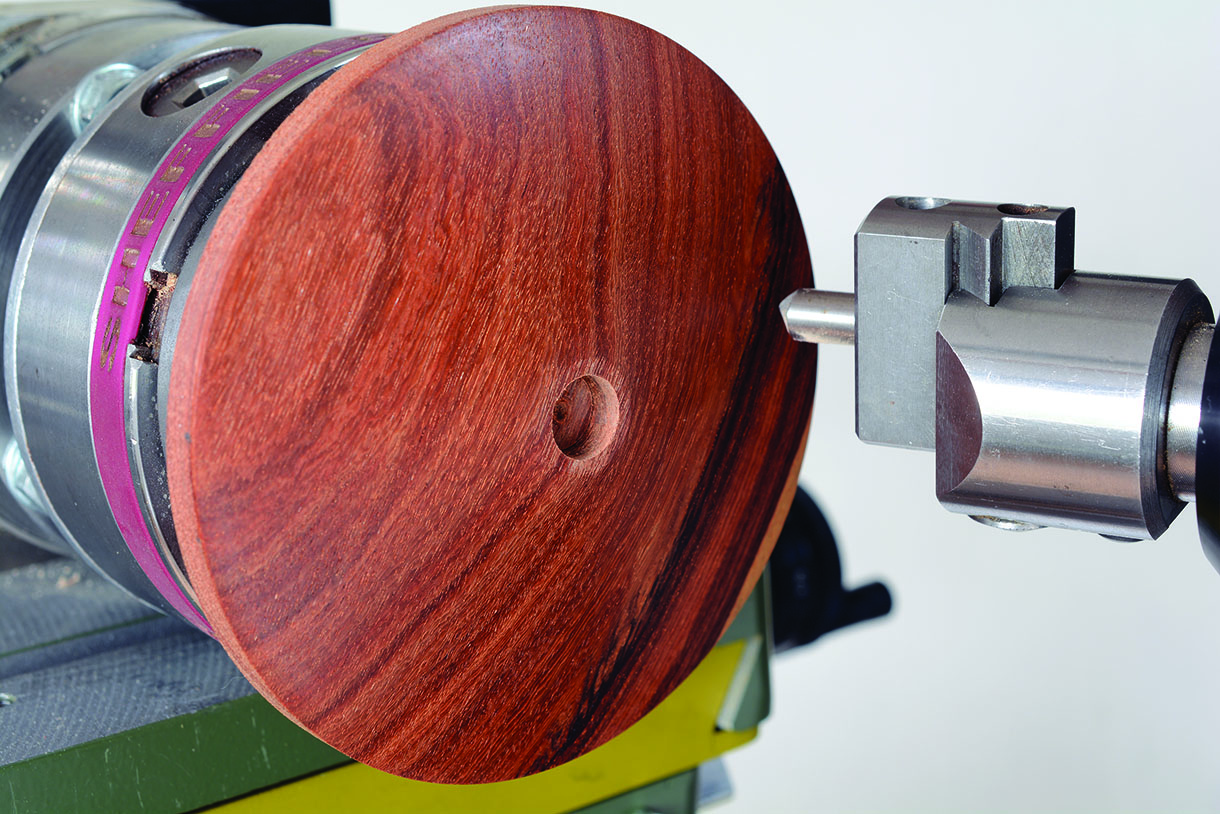
Aligning the first cut top
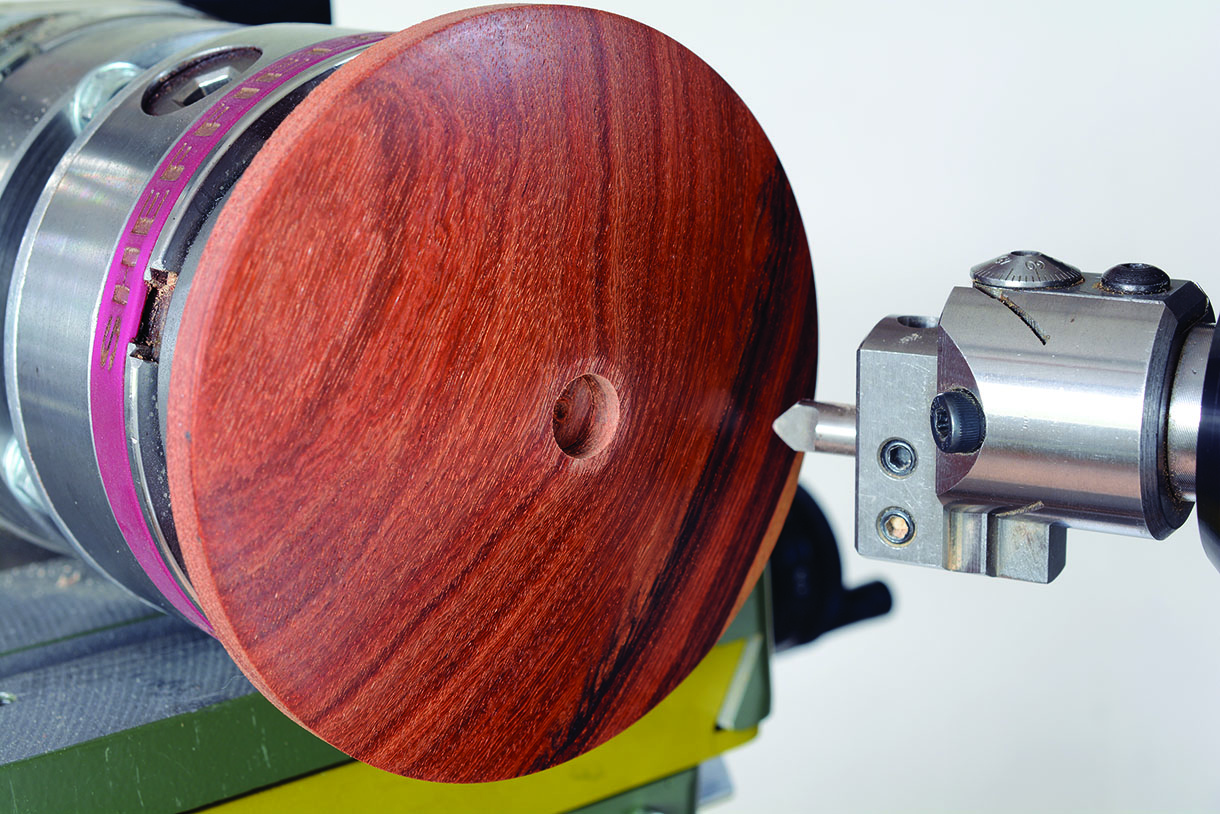
Aligning the first cut bottom
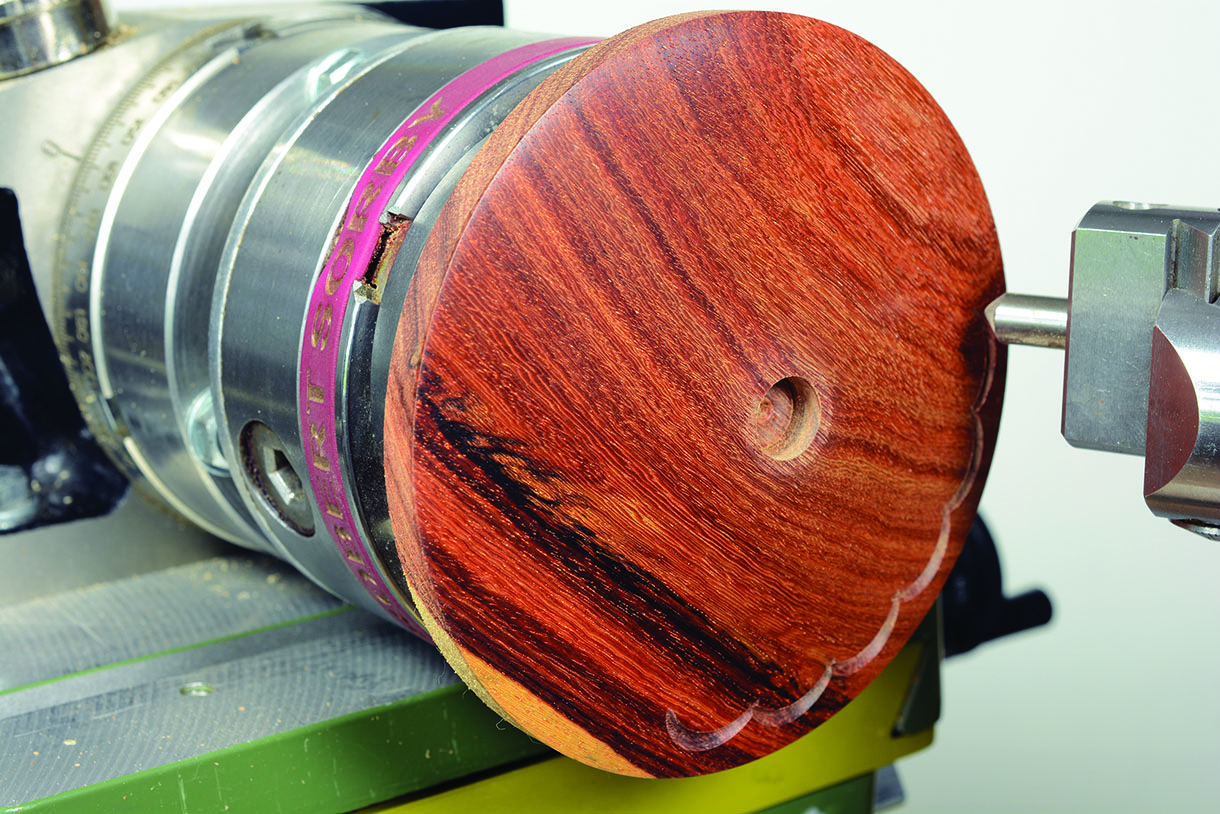
First outside cuts
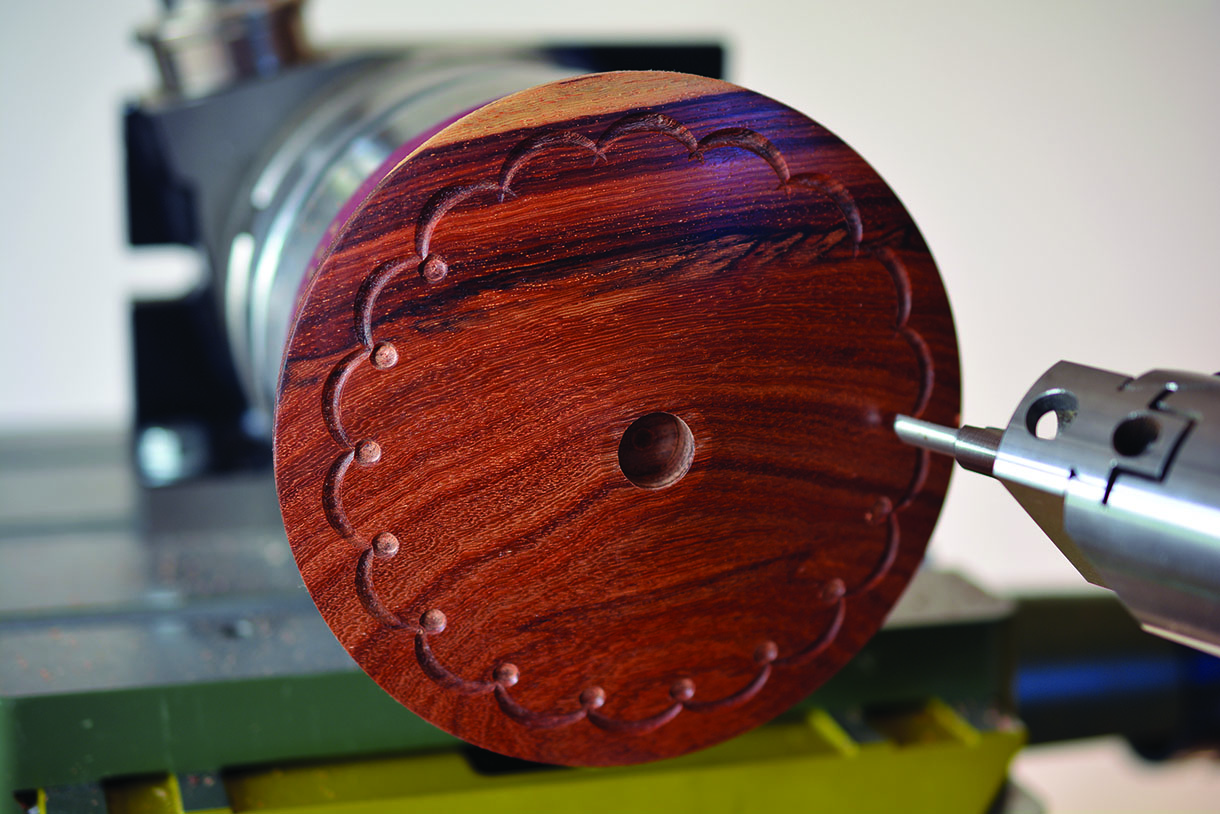
Cutting the outside dots
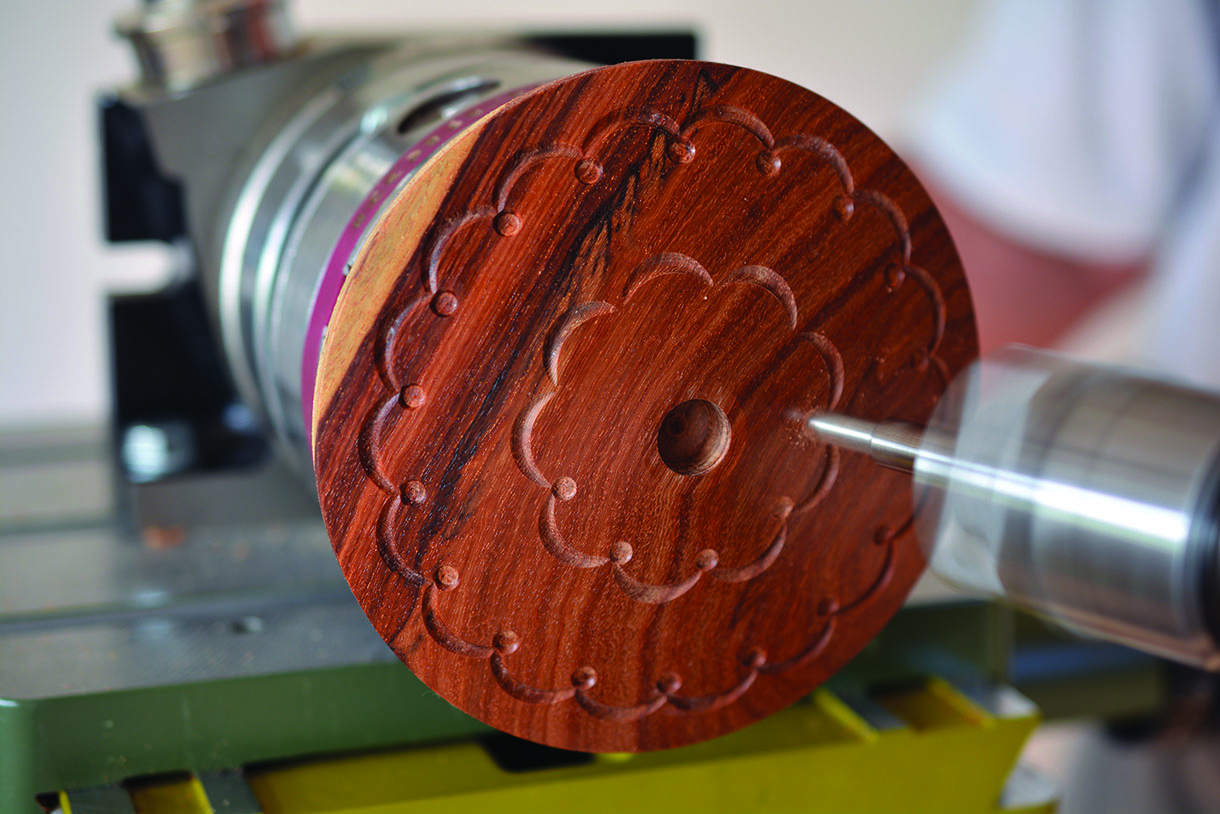
Cutting the inner ring of dots
Setting up for this pattern varies from the Barleycorn, because only part circles are to be cut. While absolute flatness of the workpiece is still required, it is not necessary to present the cutter at 90° to the work, indeed an amount of offset is required to enable the part circle to be cut requiring part of the cut to be into fresh air, therefore rotating the compound table in a clockwise directionwill provide this relief.
There now follows an amount of adjustment to set up the outer rim cuts, which involves rotating the compound table clockwise to obtain a suitable amount of offset, setting the cutter in relation to the edge together with the length of the crescent. Be aware that all these adjustments are interrelated, therefore one change will affect all other elements.
After turning the unit clockwise, rotate the cutter so the point of the cutter is facing the edge of the lid winding the Y axis until the correct distance from the edge is achieved. Now swing the cutter in an arc to determine the length of the cut, adjustment is made on the sliding dovetail. The photographs show the top and bottom of the cut. Put a pencil mark at the top of the arc, now rotate the table with the cutter at the bottom of the arc until it reaches the pencil mark. This is the length of the crescent, also giving the increment to repeat the sequence in degrees. To make the process a little easier I like to use the increments in multiples of 10. Continue to make adjustments until you are happy with the proposed cut, secure all the components and make adjustments. Carry out the safety checks then make the first light cut, which will give you an indication of the shape and position making it possible to make fine adjustments, a full cut will then cover the initial one. Now continue completing the cut.
Once the outer crescents are completed, it’s time to cut the dots and wind the work away from the cutter. Remove the cutter and replace with a straight fluted router cutter and secure, then centralise the dovetail slide using the zero on the Vernier scale for fine adjustment. The cutter should now run true. To align the cutter, turn the rotary table to 10°, then adjust the compound table placing the tip of the cutter where the crescents intersect. Making a very light cut will indicate the accuracy of the position allowing final adjustment prior to cutting.
To complete the inner crescents, including dots, repeat the process making allowances for a smaller diameter and shorter crescents.
To finish the lid, reverse the finial recess into a jam chuck enabling the chuck spigot to be removed, then completing the inside of the lid and finally gluing the finial in place.
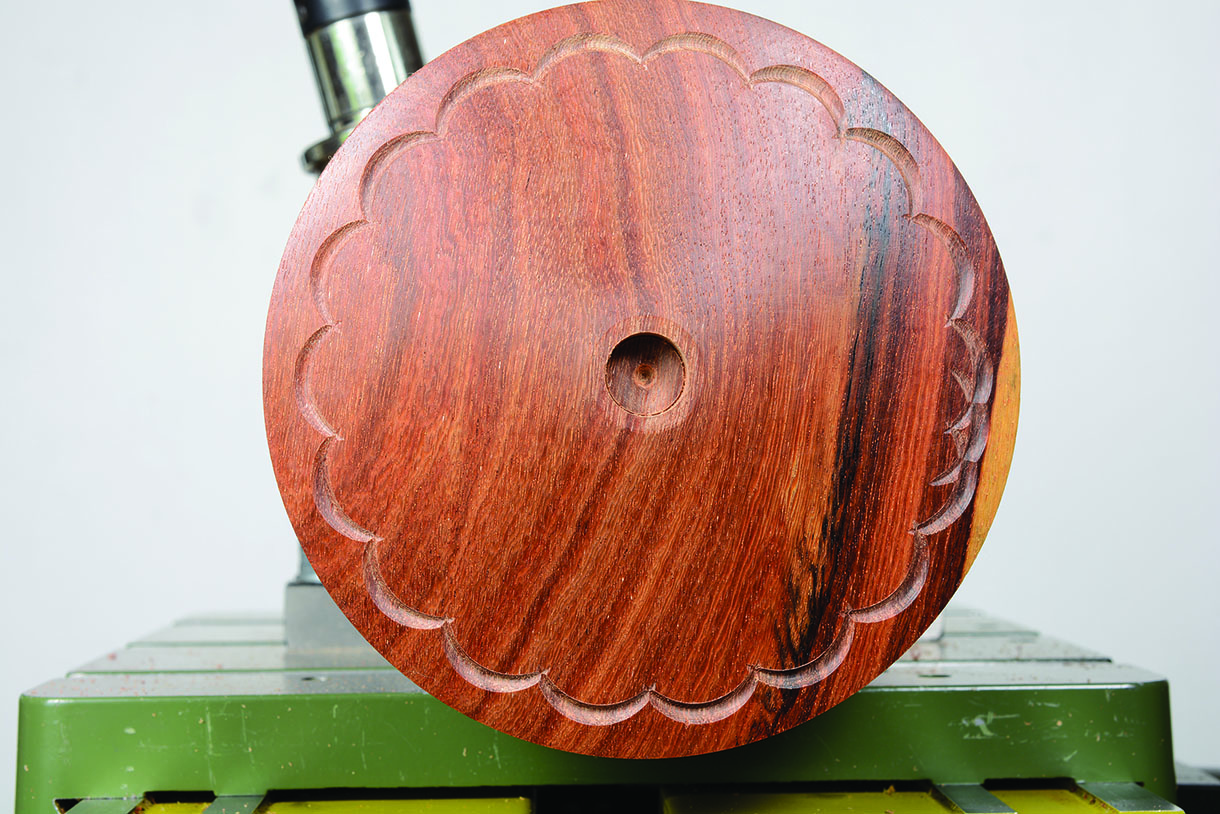
Mistake on the first attempt
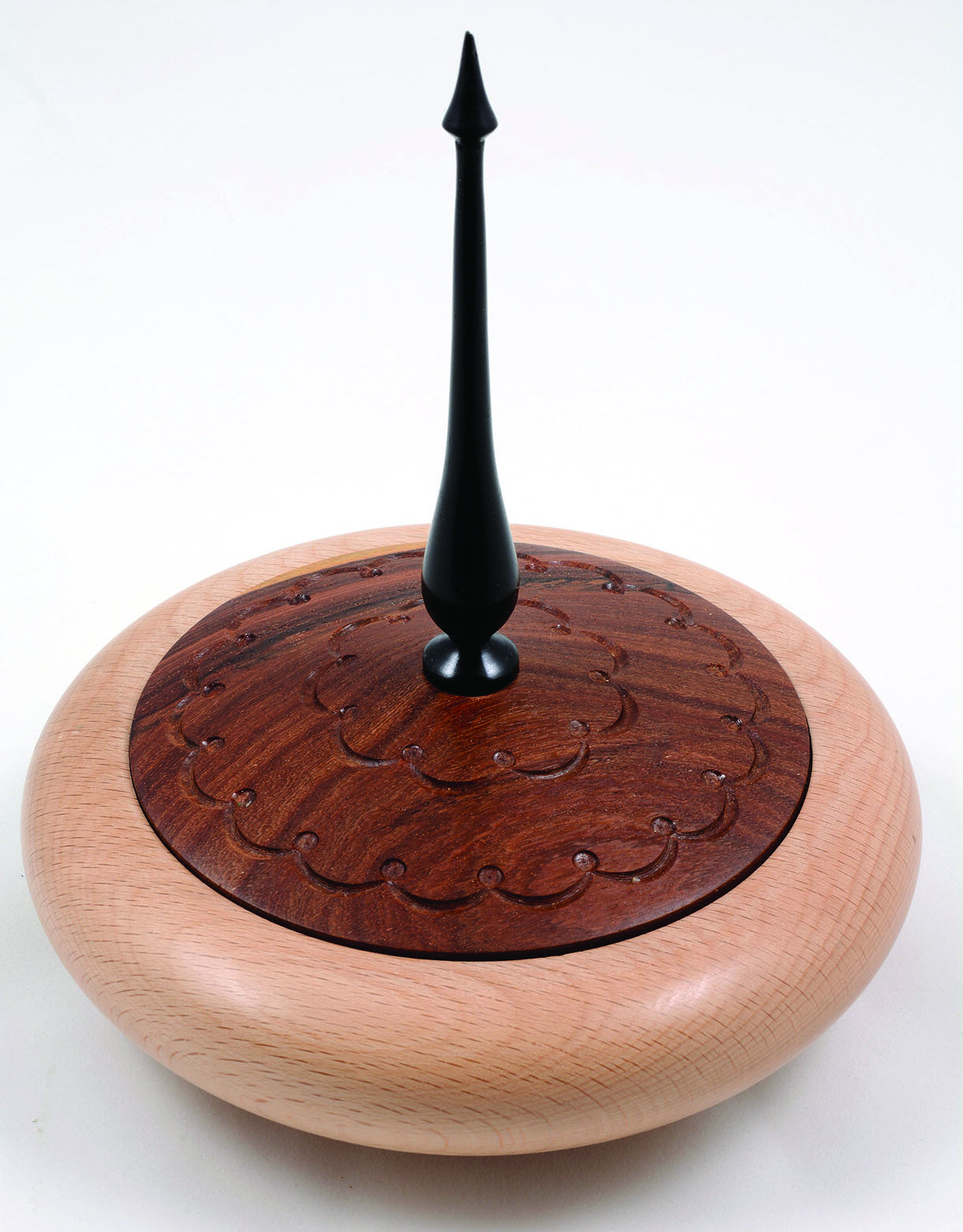
Finished box
Top tip crib sheets
The very essence of the process (once the setup is complete) is repetition. Human nature being what it is allows concentration to wonder, this happened to me while I was demonstrating the process at my club. I completely ‘lost the plot’ half way through and I found this most embarrassing. While making the lid for this article, with two cuts left on the outer circle, thinking of something else I failed to rotate the table to the correct mark (the result can be seen in the photograph above). I was then faced with the decision to change the pattern or start again, fortunately the piece was thick enough to skim. The moral here is that, although I had recognised the issue early on during the development, I devised simple sheets with the sequenced increments crossing off each division as they were completed, together with a spreadsheet detailing all the information needed to plan a sequence, I had failed to use them.
Lathe speed
As a general rule the faster the speed of the cutter the better the cut, however, the vast majority of the cuts will be with the sliding dovetail extended, which will induce vibration. The best way to reach optimum speed is to start at the slowest speed, increasing until vibration is reached. Do not stop here, but continue, the chances are this will be eliminated as speed increases. The best place to feel vibration is on top of the rotary table, not the bed bars. While some vibration may be tolerated it can cause tool chatter. Router cutters are designed to run at high speed and should only be run true in the centre without offset, therefore can be run at top speed.



